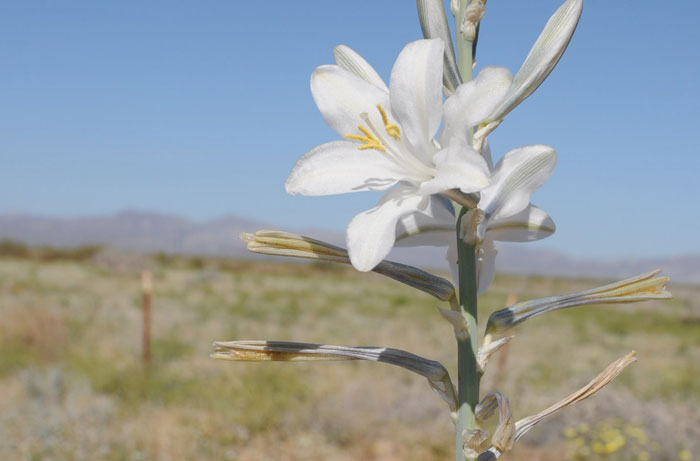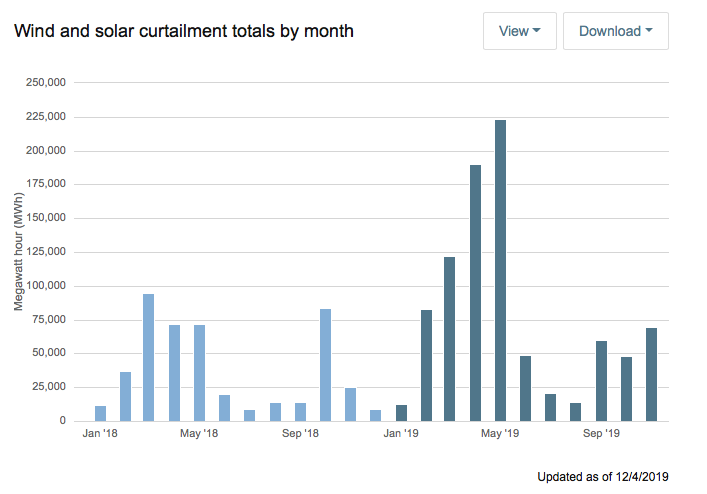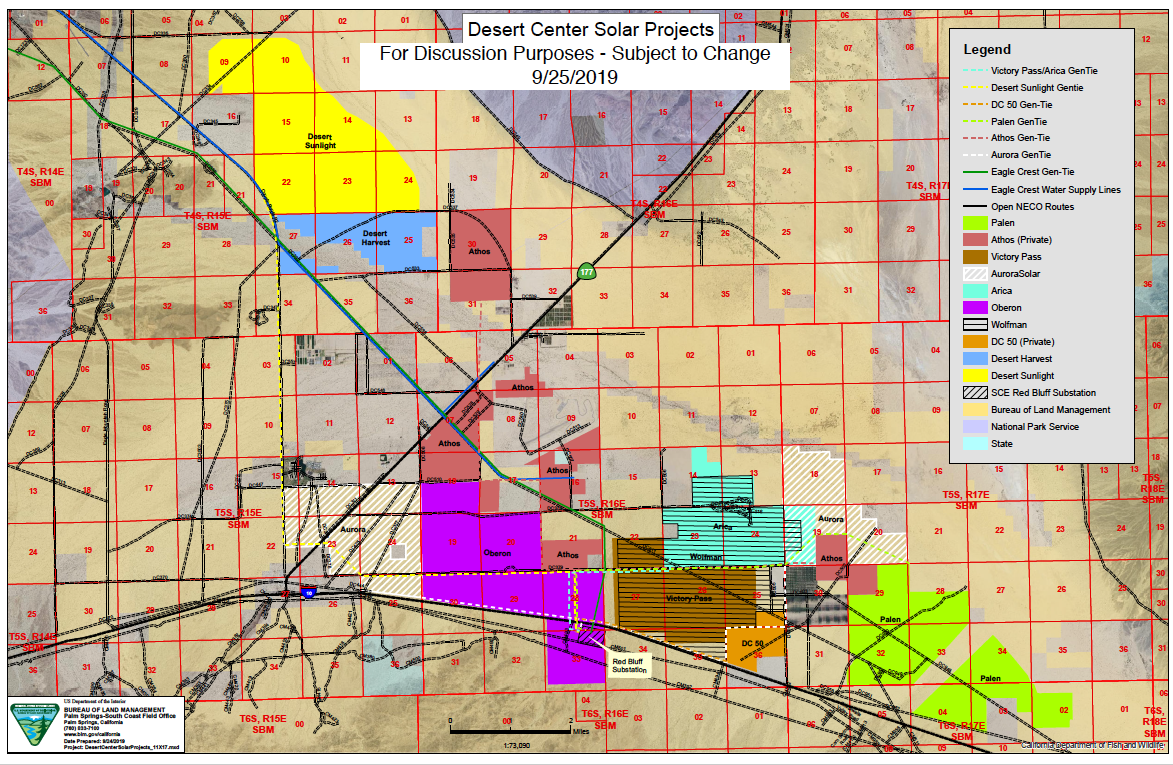Filling Up Chuckwalla Valley Desert With Energy Sprawl

^Desert lily in Chuckwalla Valley on the site of the approved Palen Solar Project, awaiting the blades and bulldozers.
December 13, 2019 - Riverside County CA - The Field Office Reports of the California Desert Advisory Council December 2019 contain a lot of good information and news about the state of the California Desert, including off-road activity, grazing allotments, restoration activities, rare species conservation, high speed rail, and renewable energy updates.
Unfortunately, a new wave of solar project applications is descending on the Chuckwalla Valley, filling in more large-scale energy sprawl on the biodiverse desertpublic lands area in the Riverside East Solar Energy Zone. Already constructed across tens of throusands of acres of once remote and wildflower-filled desert, are Desert Sunlight Solar Farm, Desert Harvest, Genesis Solar Energy Project, and several utility-scale projects across Palo Verde Mesa near Blythe. The Palen Solar Project has been approved, but not yet under construction.
Solar Oversupply and Curtailments
This Mojave-Colorado Desert transition zone is the bullseye sacrifice zone for utility-scale solar development in the Southwest at the moment, despite the fact that current level of solar overgeneration in the desert exceeds to ability of the grid to absorb it, and therefore many large-scale solar projects such as Desert Sunlight, are regulaly "curtailed" or shut down by the California Independent System Operator.
The California Independent System Operator discusses the latest solar and wind overgeneration problem:
"The shift to a clean, efficient and modern grid is essential to California's economy and its environment. This transition to a low-carbon grid provides challenges and opportunities, as the state incorporates increasing amounts of renewable energy on to the electric system. Sometimes, during the middle of the day, California's renewable resources can generate more electricity than is needed.
"During these periods of surplus energy, the ISO's market automatically reduces the production of energy from renewable resources, or “curtail" generation. In rare instances, when economic bids from generators are insufficient, ISO operators manually curtail production to maintain the balance between supply and demand.
"While curtailment is an acceptable operational tool, as increasing amounts of renewable resources, oversupply conditions are expected to occur more often. The ISO is seeking solutions to avoid or reduce the amount of curtailment of renewable power to maximize the use of clean energy sources."

^Megawatt/hours of solar and wind projects switched off to balance the grid because of too much renewable energy at midday flooding the system. California Independent System Operator accessed December 13, 2019. It's getting worse. http://caiso.com/informed/pages/managingoversupply.aspx
The solution is advanced Distributed Energy Resources and microgrids, which can have the added benefit of reducing the need for more new fire-causing transmission lines across wildlands, and also sparing communities utility Planned Saftey Power Shutoffs. Basin and Range watch is working with the think tank Solar Done Right on a white paper about this modern smart alternative.
Wave of New Solar Projects
But without planning, more solar projects are proposed to be added into the mess.
^Basin and Range Watch obtained this preliminary map of current and proposed solar projects on public and private land in Chuckwalla Valley around the town of Desert Center, September 2019. Larger image >>here.
A catalog of new solar project applications from the California Desert Advisory Committee December 2019 minutes:
Desert Quartzsite Solar Project
Desert Quartzite, LLC proposes to construct and operate a 450 megawatt (MW) solar photovoltaic (PV) energy-generating project known as the Desert Quartzite Solar Project. Desert Quartzite, LLC is a wholly-owned subsidiary of First Solar Development, Inc. The facility will utilize First Solar’s thin-film cadmium
telluride (CdTe) PV modules. The project site is located on Bureau of Land Management (BLM) lands in eastern Riverside County, approximately 2.75 miles southwest of the western extent of the City of Blythe, CA.
The proposed facility would occupy approximately 3,800 acres of land. The gen-tie line is approximately
2.8 miles long, ending at the Colorado River Substation. The BLM and Riverside County released a joint Final Environmental Impact Statement/Environmental Impact Report on September 27, and the protest period closed on October 28. The BLM anticipates issuing a ROD in December.
Crimson Solar Project
Sonoran West Holdings, LLC, a wholly owned subsidiary of ReculTent Energy, LLC proposes to construct and operate the Crimson Solar Project. The project is for a 350 MW solar PV installation with integrated energy storage, located on approximately 2,700 acres of land managed by the BLM. Recurrent Energy’s proposal includes a low impact design option and a conventional design and optional alternative design components intended to reduce some of the project impacts. The proposed project is located in unincorporated eastern Riverside County, approximately 13 miles west of Blythe, just north of Mule Mountain and just south of 1-10. The project site was formerly proposed by BrightSource Energy for development of a larger project as the Sonoran West Solar Energy Generating Station, with submittal of an Sf-299 application for CACA-05 1967 in 2009. A Plan of Development for the project was submitted to the BLM most recently in November 2017. The draft Environmental Impact Statement/Environmental Impact Report was released on November 1.
Arica Solar Project (Clearway)
SunPower Corporation filed a Right-of-Way (ROW) application in summer 2016, for a 400 MW PV project on roughly 4,000 acres of public lands near Desert Center, and submitted a Plan of Development on November 21,
2016. The BLM hosted a pre-application meeting with SunPower (previous applicant) on November 21, 2016. Clearway is now the applicant for this project going forward. The project consists of a 265 MW solar PV project located eight miles east of the 1-10 and SR 177 intersection with 50 MW storage capacity. The project will consist of two substations and 3.2 miles of 230 kV gen-tie from the switchyard to the existing Red Bluff Substation. Gen-tie will be shared with Victory Pass Solar project. The second pre-application meeting was held on May 29. This project is in the initial stages of processing.
Victory Pass Solar (formerly Jupiter) (Clearway)
Jupiter Solar filed a Right of Way application on July 6, 2015, for a solar project on roughly 1,800 acres of public lands near the Desert Center area. Clearway is now the applicant for this project going forward. The project consists of a 200 MW PV project located eight miles east of the 1-10 and SR 177 intersection with an optional 50 MW battery storage. As well as a shared 3.2 mile 230 kV gen-tie line with Arica Solar Project. The second pre-application meeting was held on May 29, 2019. This project is in its initial stages of processing.
Blythe Mesa Solar Project
On August 18, 2015, the BLM issued a Record of Decision (ROD) approving the issuance of a ROW grant in
support of the Blythe Mesa Solar Project, owned by the Renewable Energy Group, Los Angeles, CA. This 485 MW PV project will occupy 3,665 acres, located on lands under the jurisdiction of the County of Riverside, BLM, and the City of Blythe. The project will likely be developed in phases that extend over several years. The project includes construction of a 230 kV gen-tie line to connect the solar facility to the Colorado River Substation. The total length of this line would be 8.8 miles; 3.6 miles will be located on private lands within the array site boundary and 5.2 miles will be located off site on 72 acres of BLM managed lands. The solar plant will be constructed entirely on private lands. In November 2019, the BLM received an amended application.
McCoy (and Arlington) Solar Energy Project
McCoy Solar, LLC, owned by NextEra Energy, is authorized to construct a 750 MW PV solar project on 7,700 acres of BLM and 470 acres of private lands, located directly north of the Blythe Solar Project, near Blythe, CA.
The BLM issued the ROD on March 11, 2013. The right-of-way grants were issued for Units 1 and 2 on December 2, 2013, and August 12, 2014. Unit 1 is fully operational and Unit 2 (renamed the Arlington Solar Project) has not been issued a Notice to Proceed (NOP). When McCoy and Blythe were first permitted, they were approved to construct two separate gen-tie lines. When the initial projects were built, NextEra Energy built one set of poles and hung the gen-tie lines for both Blythe and McCoy solar projects. However, NextEra has requested to build the second set of poles approved under the McCoy solar project in order to build Unit 2/Arlington Solar Project of the McCoy Solar Project.
Blythe Solar Power Project
NextEra Energy holds the right-of-way on 4,318 acres for the generation of 485 megawatts of photovoltaic solar energy with the Blythe Solar Power Project, consisting of three 125 MW units and one 110 MW unit, a 230 kV
generation-tie line, operation and maintenancebBuilding, access road and other related facilities. A notice to proceed for project construction was issued on March 19, 2015. Phase I (one 125 MW unit and one 110 MW unit) was completed in December 2016. NextEra is currently constructing Phase II (two 125 MW units 3) and 4 of the solar field.
All these solar projects will need new and upgraded transmission lines:
Athos Solar Gen-Tie
Intersect Power proposes to construct and maintain a gen-tie line in support of their Athos solar facilities which
are located on private land. The gen-tie line will include up to seven miles located on BLM land, within a 100 foot right-of-way. The access roads are mainly located on previously disturbed agricultural lands; the roads will need some improvements. This project is a 220kV transmission line with up to 120 structures north of 1-10 in the Desert Center area. BLM and contractors are engaged in the last review of various resource analysis for
Environmental Assessment (EA).

